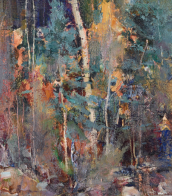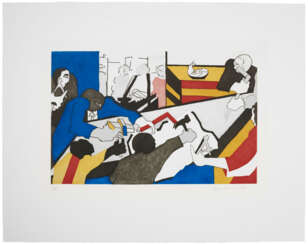jacob lawrence (1917 - 2000)

Jacob Armstead Lawrence was a pioneering American artist, renowned for his dynamic cubism and profound portrayals of African-American life and history. Born in 1917 in Atlantic City, he moved to Harlem at a young age, where he was deeply influenced by the Harlem Renaissance. This vibrant cultural period helped shape his unique artistic style, which combined abstract expression with narrative elements.
Lawrence gained national recognition at just 23 years old with his 60-panel series "The Migration of the Negro" (later known as "The Migration Series"), which depicted the mass movement of African Americans from the rural South to the urban North. This work was first displayed at Edith Halpert's Downtown Gallery in 1941, making him the first African American artist to be represented by a mainstream New York gallery.
His art often depicted both historical and contemporary themes, making significant contributions to the representation of African American history in modern art. His works are housed in prestigious institutions such as the Museum of Modern Art (MoMA) and the Phillips Collection. In addition to painting, Lawrence also dedicated much of his life to teaching, influencing generations of artists at institutions like the University of Washington.
If you're keen to explore more about Jacob Lawrence's contributions to art and culture, consider subscribing for updates on exhibitions, sales, and auction events related to his work. This subscription will keep you informed about new discoveries and opportunities to engage with Lawrence's enduring legacy.


Jacob Armstead Lawrence was a pioneering American artist, renowned for his dynamic cubism and profound portrayals of African-American life and history. Born in 1917 in Atlantic City, he moved to Harlem at a young age, where he was deeply influenced by the Harlem Renaissance. This vibrant cultural period helped shape his unique artistic style, which combined abstract expression with narrative elements.
Lawrence gained national recognition at just 23 years old with his 60-panel series "The Migration of the Negro" (later known as "The Migration Series"), which depicted the mass movement of African Americans from the rural South to the urban North. This work was first displayed at Edith Halpert's Downtown Gallery in 1941, making him the first African American artist to be represented by a mainstream New York gallery.
His art often depicted both historical and contemporary themes, making significant contributions to the representation of African American history in modern art. His works are housed in prestigious institutions such as the Museum of Modern Art (MoMA) and the Phillips Collection. In addition to painting, Lawrence also dedicated much of his life to teaching, influencing generations of artists at institutions like the University of Washington.
If you're keen to explore more about Jacob Lawrence's contributions to art and culture, consider subscribing for updates on exhibitions, sales, and auction events related to his work. This subscription will keep you informed about new discoveries and opportunities to engage with Lawrence's enduring legacy.


Jacob Armstead Lawrence was a pioneering American artist, renowned for his dynamic cubism and profound portrayals of African-American life and history. Born in 1917 in Atlantic City, he moved to Harlem at a young age, where he was deeply influenced by the Harlem Renaissance. This vibrant cultural period helped shape his unique artistic style, which combined abstract expression with narrative elements.
Lawrence gained national recognition at just 23 years old with his 60-panel series "The Migration of the Negro" (later known as "The Migration Series"), which depicted the mass movement of African Americans from the rural South to the urban North. This work was first displayed at Edith Halpert's Downtown Gallery in 1941, making him the first African American artist to be represented by a mainstream New York gallery.
His art often depicted both historical and contemporary themes, making significant contributions to the representation of African American history in modern art. His works are housed in prestigious institutions such as the Museum of Modern Art (MoMA) and the Phillips Collection. In addition to painting, Lawrence also dedicated much of his life to teaching, influencing generations of artists at institutions like the University of Washington.
If you're keen to explore more about Jacob Lawrence's contributions to art and culture, consider subscribing for updates on exhibitions, sales, and auction events related to his work. This subscription will keep you informed about new discoveries and opportunities to engage with Lawrence's enduring legacy.


Jacob Armstead Lawrence was a pioneering American artist, renowned for his dynamic cubism and profound portrayals of African-American life and history. Born in 1917 in Atlantic City, he moved to Harlem at a young age, where he was deeply influenced by the Harlem Renaissance. This vibrant cultural period helped shape his unique artistic style, which combined abstract expression with narrative elements.
Lawrence gained national recognition at just 23 years old with his 60-panel series "The Migration of the Negro" (later known as "The Migration Series"), which depicted the mass movement of African Americans from the rural South to the urban North. This work was first displayed at Edith Halpert's Downtown Gallery in 1941, making him the first African American artist to be represented by a mainstream New York gallery.
His art often depicted both historical and contemporary themes, making significant contributions to the representation of African American history in modern art. His works are housed in prestigious institutions such as the Museum of Modern Art (MoMA) and the Phillips Collection. In addition to painting, Lawrence also dedicated much of his life to teaching, influencing generations of artists at institutions like the University of Washington.
If you're keen to explore more about Jacob Lawrence's contributions to art and culture, consider subscribing for updates on exhibitions, sales, and auction events related to his work. This subscription will keep you informed about new discoveries and opportunities to engage with Lawrence's enduring legacy.


Jacob Armstead Lawrence was a pioneering American artist, renowned for his dynamic cubism and profound portrayals of African-American life and history. Born in 1917 in Atlantic City, he moved to Harlem at a young age, where he was deeply influenced by the Harlem Renaissance. This vibrant cultural period helped shape his unique artistic style, which combined abstract expression with narrative elements.
Lawrence gained national recognition at just 23 years old with his 60-panel series "The Migration of the Negro" (later known as "The Migration Series"), which depicted the mass movement of African Americans from the rural South to the urban North. This work was first displayed at Edith Halpert's Downtown Gallery in 1941, making him the first African American artist to be represented by a mainstream New York gallery.
His art often depicted both historical and contemporary themes, making significant contributions to the representation of African American history in modern art. His works are housed in prestigious institutions such as the Museum of Modern Art (MoMA) and the Phillips Collection. In addition to painting, Lawrence also dedicated much of his life to teaching, influencing generations of artists at institutions like the University of Washington.
If you're keen to explore more about Jacob Lawrence's contributions to art and culture, consider subscribing for updates on exhibitions, sales, and auction events related to his work. This subscription will keep you informed about new discoveries and opportunities to engage with Lawrence's enduring legacy.


Jacob Armstead Lawrence was a pioneering American artist, renowned for his dynamic cubism and profound portrayals of African-American life and history. Born in 1917 in Atlantic City, he moved to Harlem at a young age, where he was deeply influenced by the Harlem Renaissance. This vibrant cultural period helped shape his unique artistic style, which combined abstract expression with narrative elements.
Lawrence gained national recognition at just 23 years old with his 60-panel series "The Migration of the Negro" (later known as "The Migration Series"), which depicted the mass movement of African Americans from the rural South to the urban North. This work was first displayed at Edith Halpert's Downtown Gallery in 1941, making him the first African American artist to be represented by a mainstream New York gallery.
His art often depicted both historical and contemporary themes, making significant contributions to the representation of African American history in modern art. His works are housed in prestigious institutions such as the Museum of Modern Art (MoMA) and the Phillips Collection. In addition to painting, Lawrence also dedicated much of his life to teaching, influencing generations of artists at institutions like the University of Washington.
If you're keen to explore more about Jacob Lawrence's contributions to art and culture, consider subscribing for updates on exhibitions, sales, and auction events related to his work. This subscription will keep you informed about new discoveries and opportunities to engage with Lawrence's enduring legacy.


Jacob Armstead Lawrence was a pioneering American artist, renowned for his dynamic cubism and profound portrayals of African-American life and history. Born in 1917 in Atlantic City, he moved to Harlem at a young age, where he was deeply influenced by the Harlem Renaissance. This vibrant cultural period helped shape his unique artistic style, which combined abstract expression with narrative elements.
Lawrence gained national recognition at just 23 years old with his 60-panel series "The Migration of the Negro" (later known as "The Migration Series"), which depicted the mass movement of African Americans from the rural South to the urban North. This work was first displayed at Edith Halpert's Downtown Gallery in 1941, making him the first African American artist to be represented by a mainstream New York gallery.
His art often depicted both historical and contemporary themes, making significant contributions to the representation of African American history in modern art. His works are housed in prestigious institutions such as the Museum of Modern Art (MoMA) and the Phillips Collection. In addition to painting, Lawrence also dedicated much of his life to teaching, influencing generations of artists at institutions like the University of Washington.
If you're keen to explore more about Jacob Lawrence's contributions to art and culture, consider subscribing for updates on exhibitions, sales, and auction events related to his work. This subscription will keep you informed about new discoveries and opportunities to engage with Lawrence's enduring legacy.


Jacob Armstead Lawrence was a pioneering American artist, renowned for his dynamic cubism and profound portrayals of African-American life and history. Born in 1917 in Atlantic City, he moved to Harlem at a young age, where he was deeply influenced by the Harlem Renaissance. This vibrant cultural period helped shape his unique artistic style, which combined abstract expression with narrative elements.
Lawrence gained national recognition at just 23 years old with his 60-panel series "The Migration of the Negro" (later known as "The Migration Series"), which depicted the mass movement of African Americans from the rural South to the urban North. This work was first displayed at Edith Halpert's Downtown Gallery in 1941, making him the first African American artist to be represented by a mainstream New York gallery.
His art often depicted both historical and contemporary themes, making significant contributions to the representation of African American history in modern art. His works are housed in prestigious institutions such as the Museum of Modern Art (MoMA) and the Phillips Collection. In addition to painting, Lawrence also dedicated much of his life to teaching, influencing generations of artists at institutions like the University of Washington.
If you're keen to explore more about Jacob Lawrence's contributions to art and culture, consider subscribing for updates on exhibitions, sales, and auction events related to his work. This subscription will keep you informed about new discoveries and opportunities to engage with Lawrence's enduring legacy.

























